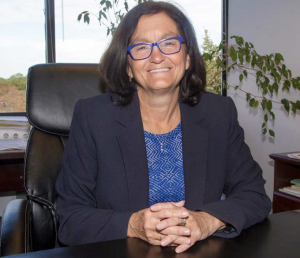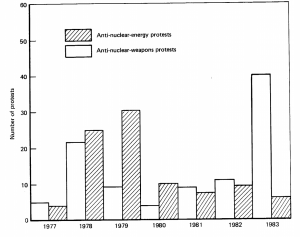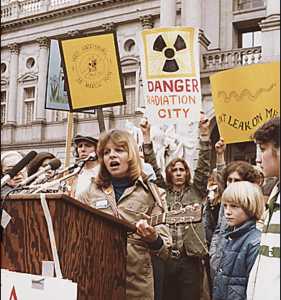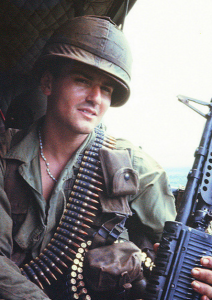“Title IX has never been about reducing opportunities for men. Title IX is simply about creating and maintaining opportunities for women.” [1] Through his participation in the local summer league as a child, Paul Richards discovered a passion for the sport of swimming. Joining the Bloomsburg University of Pennsylvania men’s swim team in 1972, Richards quickly found success in the pool, going on to break the school records in the 200 individual medley and 400 freestyle relay. [2] Crafting dedication to the sport, Richards quickly turned his passion into a coaching career spanning more than four decades. Leading teams at Hartwick College, Mary Washington College, and eventually Dickinson College, Richards is celebrated for his humble demeanor, competitive coaching style, and ability to create meaningful interpersonal relationships. Retiring from his coaching position last year, Richards persisted through times of change. As he had witnessed, the efforts made to overcome prejudice based on race, gender, sexual orientation, and religion helped to define the twentieth century. [3] Soulful in his words, Richards experienced the introduction, the reaction, and the consequences of Title IX on the athletic progression of women in collegiate competitive swimming. His anecdotal recollections illustrate the ways in which Title IX created a platform for women in collegiate sports that helped to dismantle the negative societal expectations of women, further advancing the fight against gender inequality. The devotion to which the American Yawp authors analyze the civil rights advancements, focusing on the help of organizational-led efforts, throughout the 20th century are in-depth and written with care. However, the text lacked an explanation of the societal and cultural shifts generated through the passing of Title IX. Title IX provided American citizens with the appropriate tools needed to combat gender inequality in our country.
Coined the Godmother of Title IX, Bernice Sandler was told that she “came on too strong for a woman” [4] when interviewing as a new hire in 1969. Overcome with frustration, she joined the efforts of the Women’s Equity Action League [5] to continue to fight towards gender equality. Title IX was conceived in 1972 in part by the education amendment under the federal civil rights act following the persistence of Ms. Sandler. Designed to eradicate the gender-based dissimilarities of any program receiving government funding, Title IX states that “no person in the United States shall, on the basis of sex, be excluded from participation in, be denied the benefits of, or be subjected to discrimination under any education program or activity receiving Federal financial assistance.” [6] Signed under the presidency of Richard Nixon, Title IX is responsible for the creation of societal paradigmatic shifts that allowed for the forceful redefining of female expectations, magnified through athletic competition. [7] Following the commencement of Title IX, Coach Richards recollects how it was “ it was a slow cultural change of what we thought was safe for women to do and what was culturally acceptable.” [8] The interview with Paul Richards helps to illustrate the ways in which Title IX has created groundbreaking advancements for the equality of women in which no legislature has mimicked before.

Snapshot of a headline published in the New York Times in 1974. Courtesy of ProQuest Historical Newspaper.
“No. I don’t actually. I think people were scared, and that was the unfortunate part,” [9] Richards responded when asked if Title IX was well received. According to the American Yawp authors, “women were active in both the civil rights movement and the labor movement, but their increasing awareness of gender inequality did not find a receptive audience among male leaders in those movements.” [10] Undeniably, the initial response to the passing of the bill brought fear and discomfort. Richards remembers how there was a misconception that women did not have the physical capabilities to successfully participate in collegiate sports. Used as reasoning to continue the exclusion of women in college athletics, Richards humbly recollected that “there are all kinds of misconceptions… it all comes back to culture where they say ‘I can’t push the women as hard as I push the men.’ People were scared, and that was the unfortunate part.” [11] However, such sentiment did not overwhelm the immediate action taken towards change. According to the Women’s Sports Foundation, less than thirty thousand women participated in college athletics prior to Title IX. [12] Shortly after in 1980, more than one hundred twenty-five thousand women were in participation. [13] The American Yawp attributes the societal progress to the success through “the formation of consciousness-raising groups” [14] that “crafted networks of women from which activists could mobilize support for protests” [15] in chapter 27, mimicking the recollections of Richards.
Previous organizations, while also fueled through inequality-driven pressures, set the stage for the emerging societal nonconformists behind Title IX. Prior to the passing of the bill, a lack of women sponsorships allowed for the creation of organizations such as the AIAW, Association for Intercollegiate Athletics for Women, [16] Richards explains. The AIAW was an institution “ that was created to develop and administer championship-style opportunities for women in collegiate competition.” [17] Their presence communicated and revealed to collegiate institutions the competence and dedication women exhibited to sports. While impactful, the AIAW lacked the power to spotlight and acknowledge women’s athletics. Jill Sterkel, a devoted member of the AIAW, strove for excellence in the pool. [18] As she acted as an example of a strong, victorious, and hard-working woman in collegiate swimming, her talents have not dwindled under the direction of the AIAW. However, the acknowledgment of her athletic abilities was unfortunately undermined.
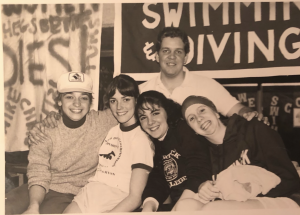
Hartwick College Women’s Relay Team, under the coaching of Paul Richards, at the second women’s NCAA sponsored championship in1983.
Through the momentum gained in the fight for equality, the passing of Title IX allowed for the NCAA to begin representing women in 1981. [19] While the American Yawp claims that “no longer would women allow society to blame the “problem that has no name” on a loss of femininity, too much education, or too much female independence,” [20] they neglect to discuss how the social advancements were directed through the formation of Title IX. While coaching the second-ever NCAA women-sponsored event, Richards remembers how “when the NCAA took over most of women’s sports, and started adding them as championship events…it was good for women’s sport because it gave them a bigger platform..” [21] An athletic establishment singularity represented by men for more than one hundred years, the NCAA’s decision to sponsor women’s sport illustrated that ever-so-changing societal climate.
Fear and discomfort transformed into understanding and unity. The success of women in athletics, magnified through their acceptance in the NCAA, catalyzed furthering gender equality efforts. After winning the national championship in 50 free, Jill Sterkel’s acceptance into the NCAA propelled her to go on and successfully compete in both the 1984 and 1988 summer Olympics. [22] The pressures created through the passing of Title IX helped to advance the involvement of women in larger, more powerful athletic organizations. Richards humbly recollected that “Title IX has helped build community. Although some think it may be divisive, I think when we lift each other up, all others in the community are lifted up as well. We instill a sense of responsibility for each other.” [23] Interestingly, Title IX “also created employment opportunities and professional career paths for women that may not have been there previously,” Richards explains. While the initial impact of Title IX was focused on athletics, the effect of the legislation has evolved to beneficially impact women in both the workforce and education system, illustrating the platform it had created on American society; a platform that was built on equality and integrity.
Richard’s progression throughout his coaching career ran linear with the progression of societal gender advancements. Title IX created the tools needed to lay the foundational platform needed for the recognition of women. Today, Dickinson has felt the presence of the adoption of Title IX as Coach Katie Wingert McArdle, Richards professors, represents female leadership in athletic competition. Breaking down stereotypes based on gender creates a free-thinking, adaptable society. As Richards illustrates, a culture that promotes gender equality is a culture that can progress. Without the cultural shift originating from the adoption of Title IX, American society would have difficulty detaching from the traditional ideologies that prohibited societal development.
[1] Interview with Coach Paul Richards, April 18, 2021
[2] “Paul Richards,” Luzerne County Sports Hall of Fame – John Louis Popple Chapter, 2020.
[3] The American Yawp. Chapter 20. The Progressive Era
[4] Alexander, Kerri Lee. Bernice Sandler. 2020.
[5] Ibid.
[6] “What is Title IX,” The President and Fellows of Harvard College, 2021.
[7] Howe, William. Title IX Coordinator Roles and Responsibilities Local School District. US Department of Education and Office for Civil Rights, 2021
[8] Interview with Coach Paul Richards, April 18, 2021
[9] Interview with Coach Paul Richards, April 18, 2021
[10] The American Yawp. Chapter 27. The Sixties
[11] Interview with Coach Paul Richards, April 18, 2021
[12] Dusenbery, Maya. Charts: The State of Women’s Athletic, 40 Years After Title IX. 22 June, 2015
[13] Wilson, Amy. 45 Years of Title IX; The Status of Women in intercollegiate Athletics. April, 2017
[14] The American Yawp. Chapter 27. The Sixties
[15] Ibid.
[16] Interview with Coach Paul Richards, April 18, 2021
[17] Sougstad, Emma. Recounting the AIAW. 18 September, 2017
[18] Ibid.
[19] Where Are the Women?: An NCAA Champion Feature. December, 2017
[20] American Yawp Chapter 27. The Sixties
[21] Interview with Coach Paul Richards, April 18, 2021
[22] Where Are the Women?: An NCAA Champion Feature. December, 2017
[23] Second Interview with Coach Paul Richards, April 27, 2021
Selected Transcript with Coach Paul Richards on April 18, 2021 on the Academic Quad at Dickinson College:
Question: From an early age, what experience did you have with women in sport?
Answer: There was a girl’s swim team. I can honestly tell you that I do not remember ever talking about it. My sisters were both on water ballet and I think that swam. I knew they [the women’s swim team] were there, but I do not remember any exposure particularly for them.
Q. When the Title IX legislature was passed in 1972, how did people react?
A. The first time I heard in-depth conversation about Title IX was when I was coaching in Virginia. So in the mid to late 80s, we are talking fourteen to fifteen years after the passage of the bill, people were starting to talk about it. It took a long time for people to actually realize that we needed to have conversation [regarding] that we were not really meeting the intent of the legislation in women’s athletics. For example, [they] probably were not getting the same financial support as men’s athletics. And one of the pieces of the bill is proportionality. What that means is that you are supposed to be spending proportionally the same amount of money on women as there are women in the school. So for women’s athletics, that budget should be the same for women and men.
Q.Do you think that Title IX was well received?
A. No. I don’t actually. I think people were scared, and that was the unfortunate part. I think male coaches [and] male athletic programs look at it oftentimes as a threat because they assume that there is this much money in the budget, so where is the money going to come from? Well, if there is not new money, it is going to come from all of our budgets. So, I think initially the response was defensive.
Q. Do you think that it was defense because they wanted the resources to allocate towards the men, or do you think it was because they were female and they did not respect them as much?
A. That is an interesting point and my guess would be both. But my guess would be originally, you know, financial. Like, where is the money going to come from, and ‘I am not giving any of my money for them to do their thing, cause they are not as important as me anyways.’ But I think it was a financial piece. And unfortunately, the perception sometimes is that men’s programs are being cut to protect women’s programs. And unfavorably, an administrator starts throwing Title IX around as the cause. Title IX has never been about reducing opportunities for men. Title IX is simply about creating and maintaining opportunities for women.
Q. How did your peers perceive you for coaching a women’s team? Did they have any sentiment towards women in sports?
A. Yeah! They never worked with women and they did not want to. There are all kinds of misconceptions, and again, it all comes back to culture where they say ‘I can’t push the women as hard as I push the men.’ Or ‘you can’t yell at the women, they’ll cry,’ those kinds of things. I think there were a lot of misconceptions and there were coaches who were probably concerned that, if I have to coach the women, I do not know how I am going to do this.
Q. Is there any experience that you can remember that made you realize that there is a problem here?
A. I think I might have became more aware of it when I moved to Virginia and I was coaching at Mary Washington College. Mary Washington College originally was a women’s college of the University of Virginia… I think it was a growth over time. Because people talked about it more. You know, when we have a law, like you said, if nobody talks about it and nobody looks at this and makes sure we are in compliance. So what I think happened was, and again, anecdotal, just a guess, but I think what happened was there came a point where women just got tired. They got tired of being nice about it. You know, we always say to people, ‘this is the way it is. We are going to change but we can’t do it right now. It is going to take some time.’ And I think that got tired of hiring that and women started taking actions.
Second Interview with Coach Paul Richards on April 27, 2021 over E-mail:
Q. Are the any anecdotes that you can remember to the way in which Title IX has had impacts here on Dickinson’s campus?
A. Title IX has helped build ‘community.’ Although some think it may be divisive, I think when we lift one up all others in the community are lifted up as well. We instill a sense of responsibility for each other. I think there could be an argument made that some men’s teams in co-ed sports have benefitted from attention that was paid to the women’s teams.


